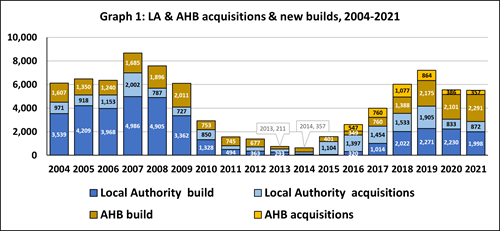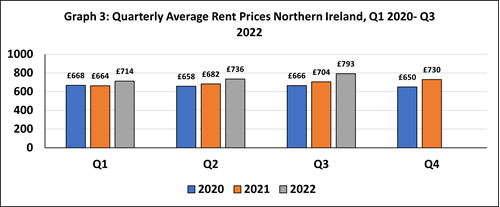03 Nov 2022
Working better together
Across the island of Ireland, the issue of housing supply and affordability has become a hot topic that shows no signs of abating. While there are differing political contexts on both sides of the border, as well as unique challenges for both the North and South, similar trends and patterns do emerge.
There is a lot to dissect in terms of housing policy, however for the purposes of this blog, we will look at the two main housing strategies launched to address supply and affordability challenges in both the North and South. We will then look at some areas where cooperation could easily be achieved by working better together.
Social Housing Need
To understand the origin of recent housing strategies in both regions, we first must examine the social housing need in the North and South.
Currently there is 44,988 households on the housing waiting list in Northern Ireland. 31,267 (69%) of these households are in housing stress.
Comparing similar stats in Southern Ireland, in 2021 there were 59,247 households assessed as qualifying for housing. However, it can be argued, that those households reliant on Housing Assistance Payment (HAP) could also be considered in housing need. This would bring the number of households in housing need closer to 122,000.
While Northern Ireland has a slightly lower rate of households in housing need as a proportion of all private households (5.9% compared to 6.4%), there was a 5% increase in the number of households on the Northern Ireland social housing waiting list between 2020 to 2021, compared to a 35% decrease in Southern Ireland. Two recent housing strategies, the Housing Supply Strategy in the North and Housing for All in the South, have both pledged around a third of their overall delivery targets to social housing.
Housing Strategies
The Housing Supply Strategy 2022-2037 is the latest policy being developed by the Department for Communities to address the housing issue in Northern Ireland. There are plans to create a housing system that can deliver over 100,000 homes during its 15-year lifetime, with one third of these properties allocated to social housing. Unfortunately, as we write, there is currently no functioning Assembly. Indeed, since it was established 24 years ago in 1998, it has been suspended for half of that period (12 years) due to political disagreements.
In 2020 in the Republic of Ireland, the Housing for All Strategy was launched with much fanfare. In this plan the government set out the goals and objectives, until 2030, with regards to housing supply and addressing the current housing crisis. The main targets include an average supply of 33,000 homes per year until 2030, with nearly a third of these being social housing (10,000 per annum).
This increase in housing supply, particularly affordable and social, is desperately needed in the South. There was a steep decline in social housing provision after the 2008 recession which has only recently started to pick up pace. Graph 1 below shows the pattern of Local Authority and AHB new build and acquisitions between 2004- 2021.

New housing models
In the South in 2020 a new cost rental model was introduced via the Affordable Housing Bill 2020. This is a new type of tenure that is financed by the Cost Rental Equity Loan (CREL) scheme. Tenants’ rent covers the cost of delivering, managing, and maintaining the homes. This is available to middle income households and several pilots are already in development.
Cost rental is needed for those on low to middle incomes as there has been a 14% increase in average quarterly rent prices in Southern Ireland between Q1 2020- Q2 2022 as shown in graph 2 below.

In Northern Ireland a similar scheme is being developed by the Department of Communities, called intermediate rent. There has been an increase of 10% in average quarterly rents in the North between Q1 2020 – Q2 2022. While slightly lower than the increase in the South, there is still the issue of affordability for renters.

There are some key differences with the intermediate rent scheme compared to cost rental. Intermediate rent intends to provide an additional rental choice for lower income households, providing secure, affordable, excellent quality, well-managed homes at below market rents. Intermediate rent can provide a solution for households struggling to meet market rents, and those wishing to enter low-cost home ownership in the future. Cost rental is focusing on middle income households.
As both are new models of housing provision related to the private rented sector it will be interesting to see how they develop and the impact they have on the housing crisis and housing supply.
Cooperation and Collaboration across the border
The CIH All Ireland summit is timely and hopefully areas of joint working can be explored across both sides of the border. Building materials inflation is rising and the availability of skilled and unskilled labour for the housing supply chain is in shorter supply. The cost of living crisis will have a major impact in both jurisdictions and we are already seeing its effects through rising fuel bills, food inflation as well as rising rents and interest rates.
There has never a greater need for an increase in the supply of decent well insulated affordable housing for a range of income groups. So where can we work together?
In the South, the Land Development Agency (LDA) was set up in 2018 and is tasked with establishing a register of public land, aiming to work with local authorities and semi-state bodies to use public land more effectively. The LDA also has first refusal on any sale of land by public bodies. Currently, no such body exists in Northern Ireland, and the Northern Ireland Housing Executive (NIHE) has ceased building new social housing since 2003, a role has been filled by housing associations. Furthermore, the NI Federation of Housing Associations (NIFHA) has highlighted the problem of land availability, and they have called for the prioritizing of surplus public sector land for housing and a similar body, like the LDA might have a role to play in this area.
There is also an opportunity of more generic knowledge and resource sharing such as retrofitting techniques, and innovative construction techniques. These topics are broader and are not necessarily dependent on legislation and the wider political context. With regards to the cross border and planning issues a formal knowledge exchange body that is aligned to the Ministerial council could also be an option for collaboration on complex issues.
Resident engagement and good practice is another area where we could share expertise. Tackling stigma in social housing; access to private money; innovative construction techniques; a common decent homes standard; assessing housing need models HNDA/Net Stock Model; ESG and sustainability reporting; social value; a house condition survey in the South similar to the HCS in the North, all Ireland approach to the provision of transient sites for travellers; a radical approach to vacants; housing associations and approved housing bodies sharing ideas and good practice and staff exchanges; and importantly strengthening the tenant voice across the island.
There are many more possibilities and opportunities to learn from both sides of the border. The current housing crisis is affecting the whole island of Ireland and will require joined up thinking and partnership to produce solutions so that all people have greater opportunities for accessing safe, secure, and affordable homes.
Paddy is the chair of Tuath Housing and a professor at the University of Ulster where he was awarded a Distinguished Community Fellowship for outstanding work in the community. Paddy has extensive academic and applied research experience with over 200 publications on housing related issues. Among Paddy’s accomplishments are his appointment as the first ever Irish President of the Chartered Institute of Housing in 2010.
Hayley works alongside Paddy at Tuath Housing as a policy and research coordinator.


